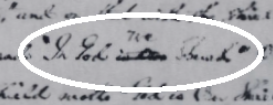
Video Upload Options
"In God We Trust" (also rendered as "In God we trust") is the official motto of the United States and of the U.S. state of Florida. It was adopted by the U.S. Congress in 1956, replacing E pluribus unum ("Out of many, one"), which had been the de facto motto since the initial design of the Great Seal of the United States. While the earliest mentions of the phrase can be found in the mid-19th century, the origins of this phrase as a political motto lie in the American Civil War, where Union supporters wanted to emphasize their attachment to God and to boost morale. The capitalized form "IN GOD WE TRUST" first appeared on the two-cent piece in 1864; it was not printed on paper currency until 1957 and on some postage stamps until 1954. A law passed in July 1955 by a joint resolution of the 84th Congress (Pub.L. 84–140) and approved by President Dwight Eisenhower requires that "In God We Trust" appear on all United States dollar . Two years later, the phrase was used on paper money for the first time — on the updated one-dollar silver certificate that entered circulation on October 1, 1957. The 84th Congress later passed legislation (Pub.L. 84–851), also signed by President Eisenhower on July 30, 1956, declaring the phrase to be the national motto. Several states have also mandated or authorized its use in public institutions or schools; while Florida, Georgia and Mississippi have incorporated the phrase in some of their state symbols. The motto has also been used in some cases in other countries, most notably on Nicaragua's coins.The motto remains popular among the American public. According to a 2003 joint poll by USA Today, CNN, and Gallup, 90% of Americans support the inscription "In God We Trust" on U.S. coins; and a 2019 student poll by College Pulse showed that 53% of students supported its inclusion in currency. Some groups and people in the United States, however, have objected to its use, contending that its religious reference violates the Establishment Clause of the First Amendment. These groups believe the phrase should be removed from currency and public property, which has resulted in numerous lawsuits. This argument has not overcome the interpretational doctrine of accommodationism, which allows the government to endorse religious establishments as long as they are all treated equally, and that of "ceremonial deism", which states that a repetitious invocation of a religious entity in ceremonial matters strips the phrase of its original religious connotation. The New Hampshire Supreme Court, as well as Second, Fourth, Sixth, Eighth, Ninth, and Tenth Circuits have all upheld the constitutionality of the motto in various settings. The Supreme Court has discussed the motto in footnotes but has never directly ruled on its compliance with the Constitution.
1. Origins
The earliest recorded usage of the motto in English was in January 1748, when The Pennsylvania Gazette reported on the colours of Associators regiments, namely that of Benjamin Franklin's Pennsylvania militia, one of which said: "IX. A Coronet and Plume of Feathers. Motto, In God we Trust."[1][2][3] According to Thomas S. Kidd, an American historian, this appears to be an isolated instance of an official usage, which could be traced to some renderings of Psalm 56:11.[4]
The precise phrase, “In God We Trust” is also found in a publication of Isaac Watts’ Psalter which was revised and printed in America in 1785. Watts had translated Psalm 115:9-11 with the words, “Britain, trust the Lord.” An American publisher, Joel Barlow, sought to revise Watts’ Psalter for an American audience. Barlow's goal was to modify Watts in such a way as to purge the un-American flavor. Barlow simply translated Psalm 115: 9–11 with the words “In God we Trust.”[5]

There were several other unrelated recordings of the motto. It can be encountered in some literary works of the early 19th century.[8] One of them, "Defence of Fort M'Henry", contained a version of the motto and subsequently became the national anthem of the United States. It also appeared in 1845, when D.S. Whitney published an anti-slavery hymn in The Liberator.[9][10] Odd Fellows have also used the phrase as their motto from the 1840s at least into the 1870s.[10][11][12]
2. Motto on U.S. Currency
2.1. Initial Adoption
In a letter dated November 13, 1861, Rev. Mark R. Watkinson of Ridleyville, Pennsylvania (pastor of the Prospect Hill Baptist Church in present-day Prospect Park, Pennsylvania), petitioned the Treasury Department to add a statement recognizing "Almighty God in some form on our coins" in order to "relieve us from the ignominy of heathenism".[13][14][15] At least part of the motivation was to declare that God was on the Union side of the Civil War,[11][13] given that the Confederacy, unlike the Union, has invoked God in their Constitution.[16] This sentiment was shared by other citizens who supported such inclusion in their letters.[17] Indeed, the 125th Pennsylvania Infantry for the Union Army assumed the motto "In God we trust" in early August 1862.[18]
In the South, the phrase has also gained significant traction. A Confederate bunting with “In God We Trust” printed in the center, dated to late 1861 or early 1862 and attributed to the 37th Arkansas Infantry Regiment, was probably captured by the 33rd Iowa Infantry Regiment at the Battle of Helena and is currently in possession of the Iowa Historical Society.[19][20] Another flag with exactly the same motto, this time of the 60th Tennessee Infantry Regiment, was captured in the course of the Battle of Big Black River Bridge.[21] Additionally, in 1864, Harper's Weekly reported that the Union Navy had captured a flag whose motto said: "Our cause is just, our duty we know; In God we trust, to battle we go."[22] Other Confederate symbols included close paraphrasing of the motto, such as the banner of the Apalachicola Guard of Florida (In God is our trust)[23] and "The Star-Spangled Cross and the Pure Field of White", a popular song in the Southern military whose refrain contains the following passage: "Our trust is in God, who can help us in fight, And defend those who ask Him in prayer."[24]
President Abraham Lincoln's Treasury Secretary, Salmon P. Chase, a lifelong evangelical Episcopalian who was known for his public shows of piety,[11][25] acted swiftly on the proposal to include a motto referring to God and directed the then-Philadelphia Director of the Mint and member of the National Reform Association, James Pollock, to begin drawing up possible designs that would include the religious phrase.[14] Chase chose his favorite designs and presented a proposal to the Congress for the new designs in late 1863. He then decided on the final version of the new motto, "In God We Trust," in December 1863.[26] Walter H. Breen, a numismatist, wrote that Chase drew inspiration from the motto of Brown University of Providence, Rhode Island, In Deo speramus, which is Latin for a similarly sounding "In God we hope".[27] Lincoln's degree of involvement in the process of the motto's approval was unclear, though he was aware of such talks.[28]
As Chase was preparing his recommendation to Congress, it was found that the federal legislature passed a bill on January 18, 1837, which determined the mottos and devices that should be stamped on U.S. coins. This meant that enactment of some additional legislation was necessary before "In God We Trust" could be engraved. Such bill was introduced and passed as the Coinage Act of 1864 on April 22, 1864, allowing the Secretary of the Treasury to authorize the inclusion of the phrase on one-cent and two-cent coins.[13]
On March 3, 1865, the U.S. Congress passed a bill, which Lincoln subsequently signed as the last act of Congress prior to his assassination,[10] that allowed the Mint Director to place "In God We Trust" on all gold and silver coins that "shall admit the inscription thereon", subject to the Secretary's approval.[13][29] In 1873, Congress passed another Coinage Act, granting the Secretary of the Treasury the right to "cause the motto IN GOD WE TRUST to be inscribed on such coins as shall admit of such motto".[30]
In God We Trust (or, rarely, its variation, God We Trust) first appeared on 2¢ coins, which were first minted in 1863 and went into mass circulation the following year.[31] According to David W. Lange, a numismatist, the inclusion of the motto on a coin was a major driver for the popularisation of the slogan.[32] Other coins, that is, nickels, quarter dollars, half dollars, half eagles and eagles, have had In God We Trust engraved from 1866 on.[33] Dollar coins got the motto in 1873 for trade dollars and 1878 for common circulation Morgan dollars.[33] However, there was no obligation for the motto to be used, so some denominations still didn't have it. Others, such as nickels, have seen the phrase disappear after a redesign, so that by the late 19th century, most of the coins did not bear the motto.[34] Finally, in 1892, an oversight during the amendment of the Coinage Act struck out the language that mandated inclusion of the phrase.[35]
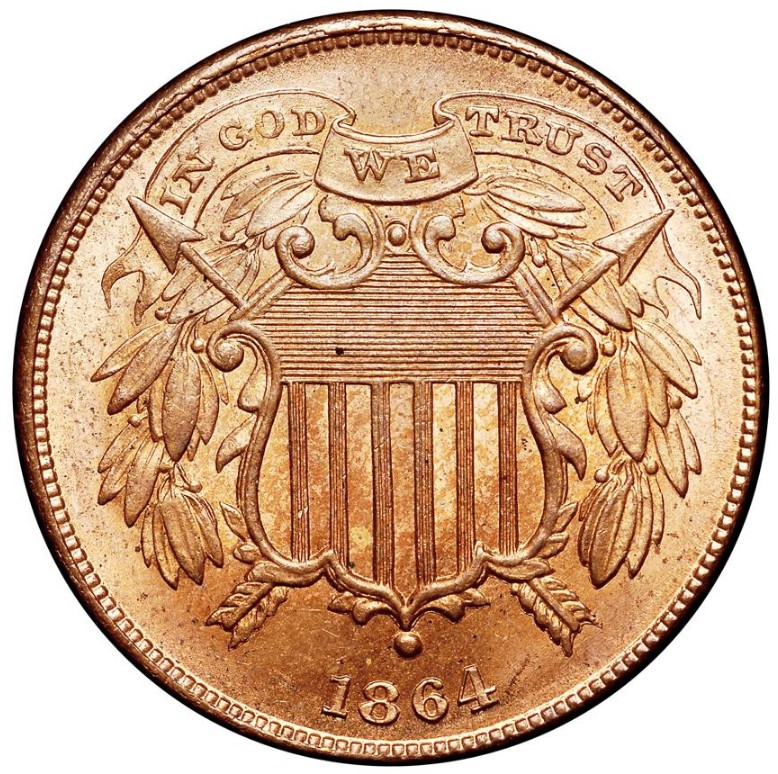
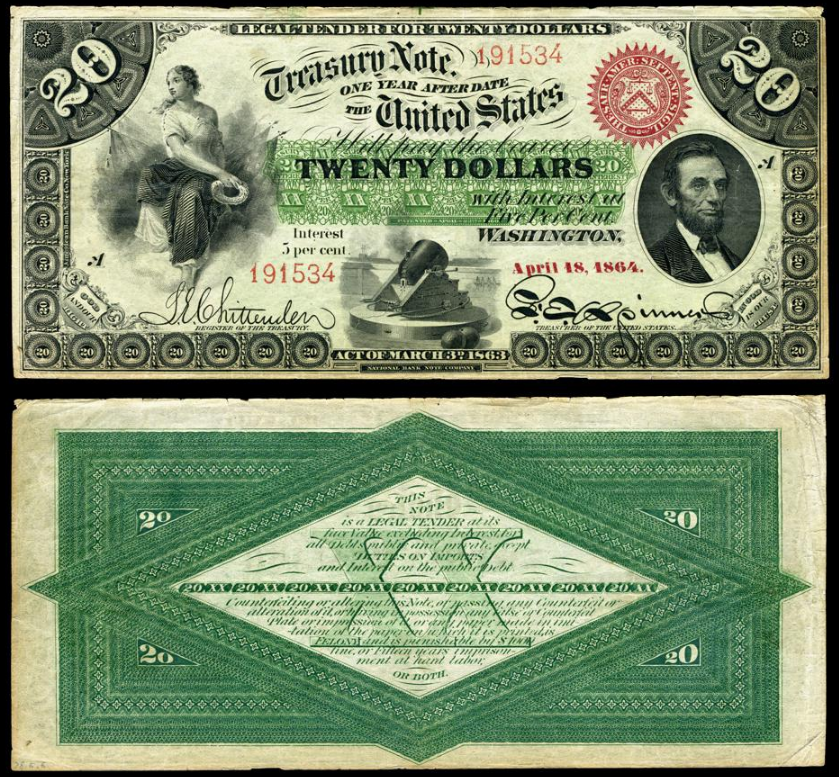
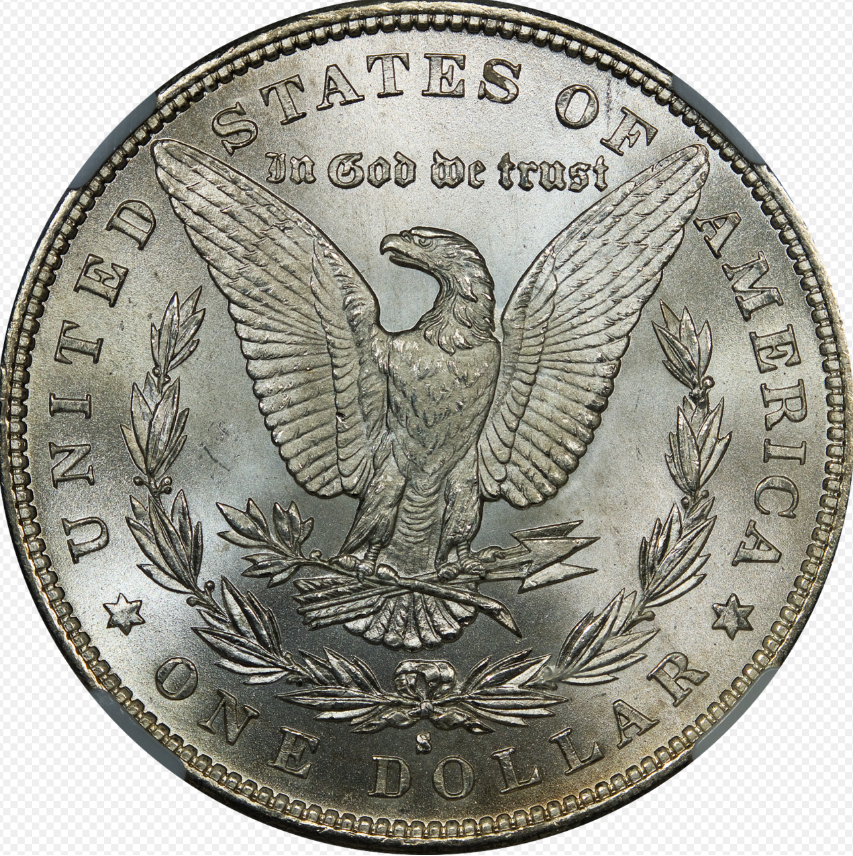
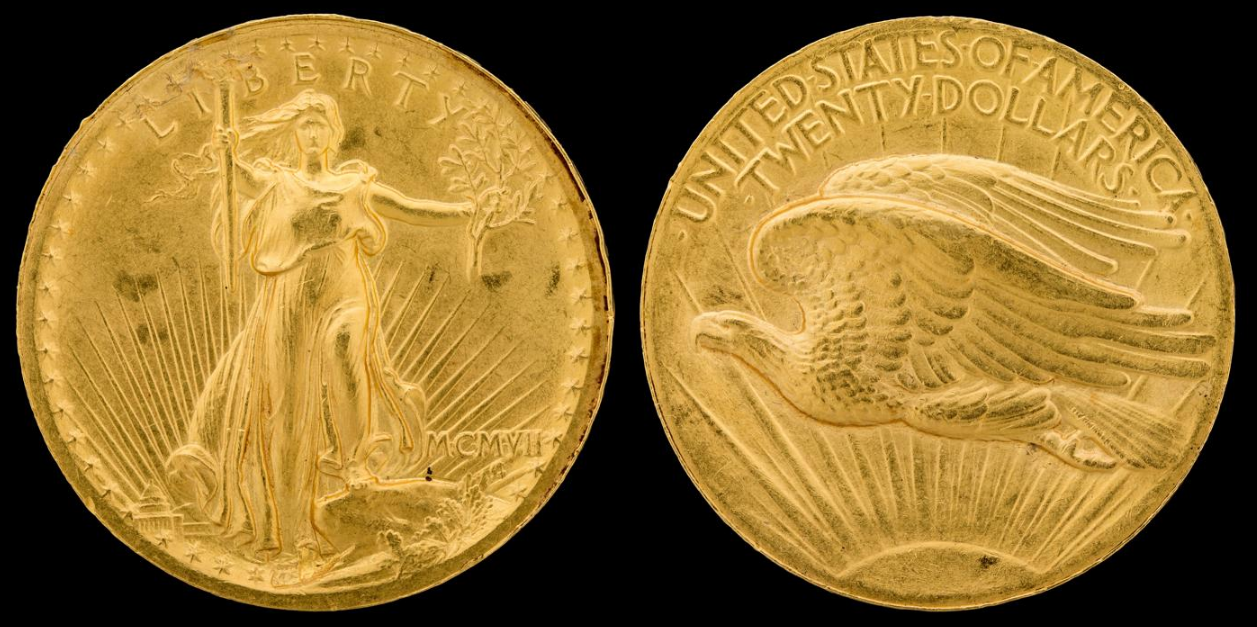
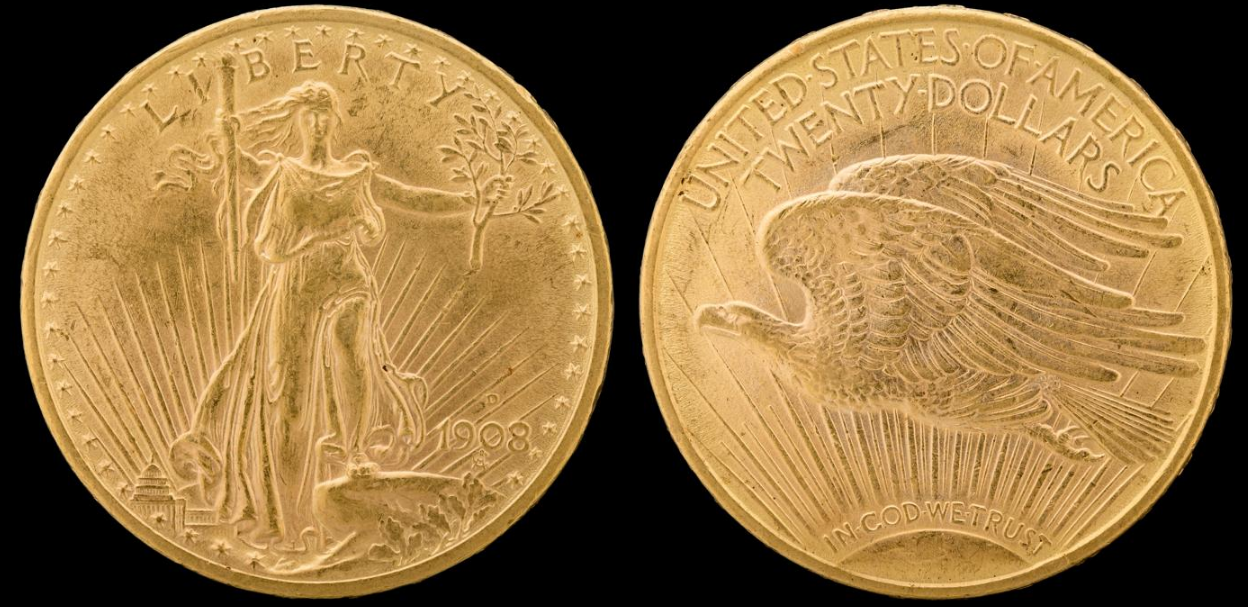
Banknotes did not have formal authorization, or mandate, to have "In God We Trust" engraved until 1955. However, a version of the motto (In God Is Our Trust) first made a brief appearance on the obverse side of the 1864 $20 interest-bearing and compound interest treasury notes, along with the motto "God and our Right".[36][37]
Reactions
The initial reactions of the general populace was far from unanimous approval. On the one hand, Christian newspapers were generally happy with the phrase being included in coins, though some advocated for more religiously connotated mottos, such as "In God alone is our trust" or "God our Christ".[10] On the other, non-religious press was less impressed by the developments. The New York Times editorial board asked to "let us try to carry our religion—such as it is—in our hearts, and not in our pockets" and criticized the Mint for including the motto only on golden and larger silver coins.[38] New York Illustrated News ridiculed the new coins for marking "the first time that God has ever been recognized on any of our counters of Mammon,"[10] with a similar comparison made by the Detroit Free Press.[11] The different opinions on its inclusion eventually grew into a dispute between secularists and faith congregations.[11] Others still started to make jokes of "In God We Trust". The American Journal of Numismatics suggested that people would misread the motto as "In Gold we Trust", which they said was "much nearer the fact".[39] Newspapers also started reporting on puns made of the slogan. Already in 1860s, newspapers reported signs reading "In God we Trust — terms cash," "In God we trust. All others are expected to pay cash" and the like.[2][40]
The phrase, however, gradually became a symbol of national pride. Just six years after it first appeared on coins, the San Francisco Chronicle called it "our nation's motto"; similarly, groups as diverse as prohibitionists and suffragists, pacifists and nativists, Democrats and Republicans, Christians and Jews all adopted the motto or endorsed its usage by the end of the 19th century.[11] The motto stayed popular even as fewer denominations had "In God We Trust" embossed on coins.[10]
2.2. 1907 Saint-Gaudens Coins Controversy
- In 1904, President Theodore Roosevelt sought to beautify American coinage and decided to give the task to his friend, Augustus Saint-Gaudens,[27] who, after several delays and technical issues with his design, produced a new design for eagles and double eagles. Roosevelt specifically instructed Saint-Gaudens not to include "In God We Trust" on the coins, as the President feared that these coins would be used to further ungodly activities, such as gambling, and facilitate crime.[27][41] Saint-Gaudens did not oppose the order, as he thought that the phrase would distract from the coin's design features.[41]
The coin, whose ultra-high relief version is now considered one of the most beautiful coins ever struck in the U.S.,[41][42] was indeed appreciated for its esthetics by art critics.[43] However, a scandal immediately erupted over the lack of "In God We Trust" on the eagles and double eagles.[44][45] Theodore Roosevelt insisted that while he was in favor of placing the motto on public buildings and monuments, doing so for money (or postage stamps and advertisements) would be "dangerously close to sacrilege":[26]
Press response was largely negative. Most news outlets affiliated with Christian organisations, as well as The Wall Street Journal , The Philadelphia Press and other newspapers were critical of the decision, with accusations amounting to the President being guilty of premeditated assault on religion and disregard for Americans' religious sentiments.[43] Atlanta Constitution wrote that people were to choose between "God and Roosevelt", while The New York Sun published a poem mocking Roosevelt's attitude.[26] In contrast, The New York Times , Chicago Tribune, and some religious newspapers such as The Churchman, sided with the President,[11][43] who was both stunned and irritated by people's opposition to excluding the motto. This prompted debate in Congress, which quickly decided to reinstate the motto on the coins in an act adopted in 1908. As a result of controversy, relevant design changes were subsequently introduced by the Mint Chief Engraver, Charles E. Barber.[35]
Other coins have also retained or renewed the usage of the motto. All gold coins and silver $1 coins, half dollars and quarters have had the motto engraved since July 1, 1908; pennies followed in 1909 and dimes in 1916.[13] Since 1938, all U.S. coins have borne the "In God We Trust" inscription on them.[13]
2.3. Road to the Universal Mandate
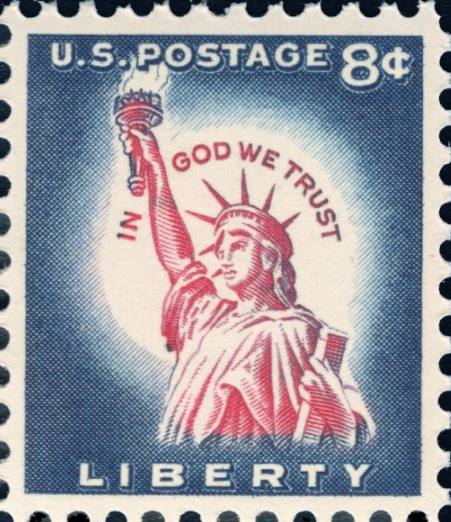
It is generally thought that during the Cold War era, the government of the United States sought to distinguish itself from the Soviet Union, which promoted state atheism and thus implemented antireligious legislation,[46] therefore, a debate for further usage of religious motto was started in Congress. However, Kevin M. Kruse argues in his book[47] that the opposition of the conservatives against the New Deal, and their subsequent successful campaigns to expand the influence of religion, were the main factors that contributed to further adoption of "In God We Trust".
The Eisenhower administration struck a deeply religious tone, which proved a fertile ground for lobbying for inclusion of the motto in further usages,[48] often attributed to the influence of Billy Graham, a prominent evangelist of the time.[49] After intense public pressure for inclusion of the national motto, it appeared for the first time on some postage stamps of the 1954 Liberty Issue,[50][51][52] though lobbying for universal inclusion by Michigan Senator Charles E. Potter and Representative Louis C. Rabaut failed.[48]
The following year, Democratic Representative Charles Edward Bennett of Florida cited the Cold War when he introduced H. R. 619, which obliged "In God we trust" to be printed on all banknotes and struck on all coins, in the House, arguing that "[in] these days when imperialistic and materialistic communism seeks to attack and destroy freedom, we should continually look for ways to strengthen the foundations of our freedom".[53][54] The American Numismatic Association and the American Legion concurred and made resolutions urging to promote further usage of "In God We Trust".[55][56]
On July 11, 1955, the bill, having passed with bipartisan support of both chambers of Congress, was signed into law by President Eisenhower.[57][58] Since all coins already complied with the law, the only changes were made to the paper currency. The motto first appeared on the $1 silver certificate in 1957, followed by other certificates. Federal Reserve Notes and United States Notes[59] were circulated with the motto starting from 1964 to 1966, depending on the denomination.[13][60][61][62]
3. Adoption and Display by Government Institutions in U.S.
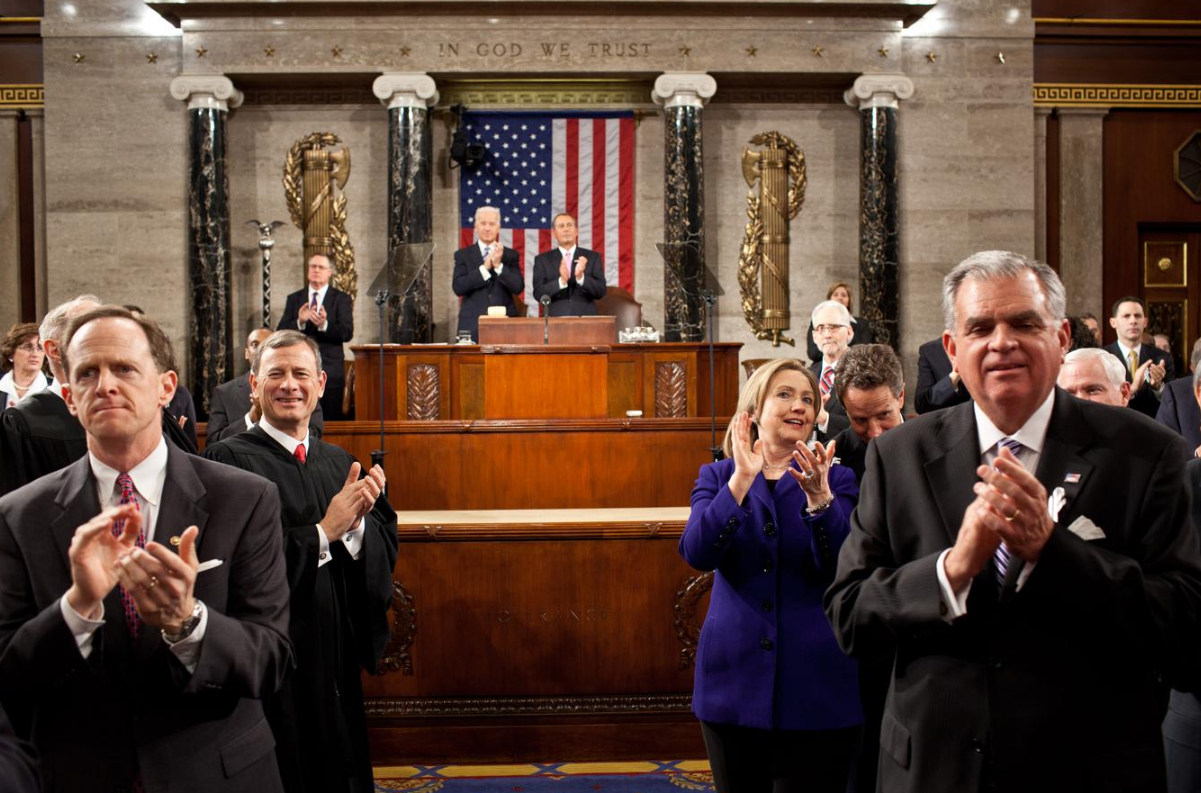
3.1. Federal Government
On July 30, 1956, the 84th Congress passed a joint resolution "declaring 'IN GOD WE TRUST' the national motto of the United States."[63] The resolution passed both the House and the Senate unanimously and without debate.[64][65][66] It replaced E pluribus unum, which had existed before as a de facto official motto.[67] The United States Code at 36 U.S.C. § 302, now states: "'In God we trust' is the national motto." The resolution was reaffirmed in 2006, on the 50th anniversary of its adoption, by the Senate,[68] and in 2011 by the House of Representatives, in a 396 to 9 vote.[69][70] In 2000, the House additionally encouraged to publicly display the motto.[71][72]
The House of Representatives features the motto above the rostrum of the Speaker, which was carved in the wall in December 1962.[73]
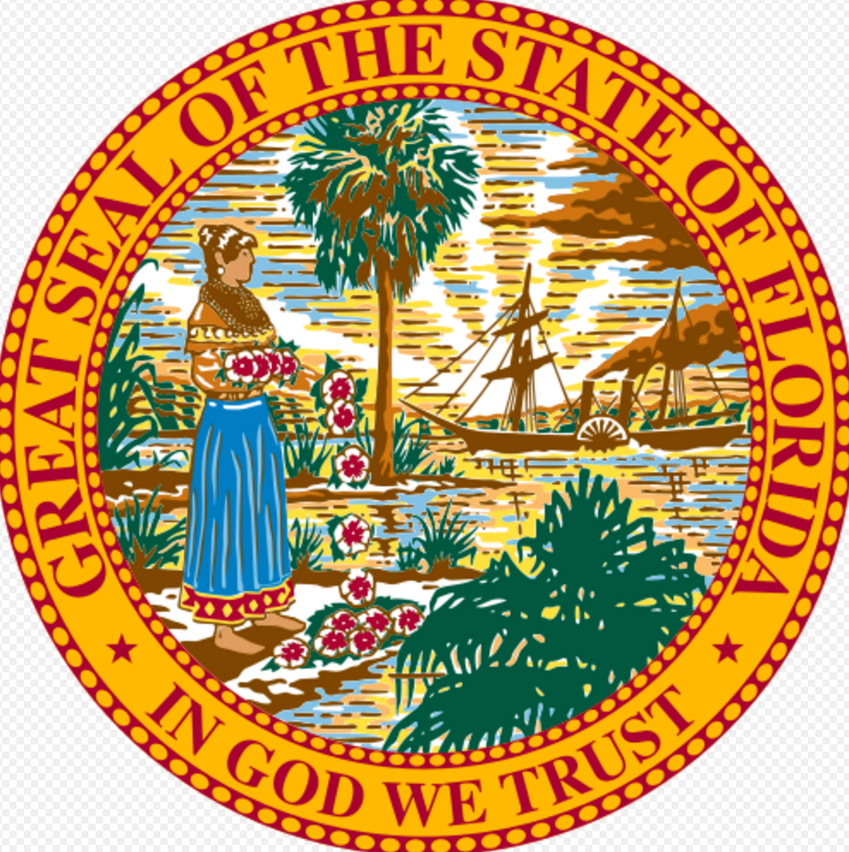
3.2. State and Local Governments
Adoption of the national motto in state symbols
Three states have adopted "In God We Trust" as part of official symbolics of the state.
In Florida, HB 1145 provided for the adoption of "In God We Trust" as the official state motto, instead of fairly similar "In God Is Our Trust", effective July 1, 2006.[74][75][76] The motto has also appeared on the seal of Florida[77] and on the flag of Florida, as the seal is one of its elements, since 1868.[78]
Georgia's flag features the motto since 2001, which was retained after a redesign two years later.[79]
In Mississippi, the Mississippi Senate voted to add the words, "In God We Trust" to the state seal, justifying it as an effort to protect religious freedom. The change was made effective on July 1, 2014.[80][81] Six years later, Mississippi Governor Tate Reeves signed into law a bill requiring that the state's flag, which had contained the Confederate battle emblem, be replaced with a new one containing the phrase "In God We Trust."[82] A new flag containing the motto was approved by voters in a referendum, and it became the official state flag in January 2021.[83]
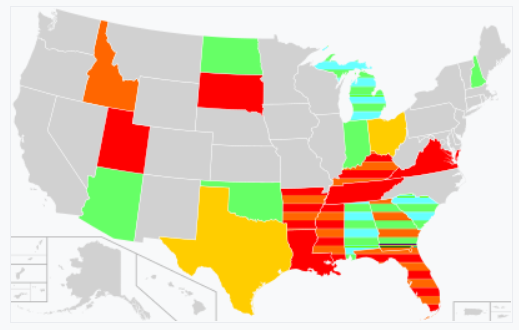
Mandating display
- Arkansas: In March 2017, Act 911, sponsored by state Representative Jim Dotson, made it a requirement of Arkansas state law for public schools to display posters with the national motto, if these were donated.[84][85] In 2019, the law was later amended to require public display of the national motto in public schools, higher education institutions and state government buildings, if funds are available for that purpose.[86]
- Florida: In early 2018, Kimberly Daniels, a Democrat who served as a representative for the Florida House of Representatives, introduced HB 839, a bill that requires public schools to display the motto "In God We Trust" in a conspicuous place. On February 21, 2018, the bill passed 97 to 10 in the House.[87][88] Governor Rick Scott then signed the mandate into law.[89][90]
- Idaho: House Concurrent Resolution 32, adopted in March 2020, mandates that the national motto be placed over the chairs of presiding officers of both chambers of Idaho Legislature.[91]
- Kentucky: In 2014, a law was passed that obliged display of the national motto in legislative buildings and in committees.[92] In June 2019, a bill sponsored by state Representative Brandon Reed of Hodgenville was passed that required Kentucky public schools to display the motto "in a prominent location", beginning from the 2019–20 school year.[93][94] To protest the requirement, Fayette County Public Schools, a school district which serves Lexington, complied by posting framed one-dollar bills, which bear the slogan,[94][95] while in LaRue County, of which Hodgenville is seat, schools were using oversized images of pennies.[94]
- Louisiana: A bill requiring public display of the motto in public schools was introduced by state Senator Regina Ashford Barrow in March 2018. It was passed unanimously both in the Senate (33 to 0) and in the House (93 to 0).[96] It was signed into law by Governor John Bel Edwards in May that year.[97][98] The bill also mandated school instruction about "In God We Trust" as part of the social studies curriculum.[96][99]
- Mississippi: In March 2001, Governor of Mississippi Ronnie Musgrove signed legislation requiring the motto "In God We Trust" to be displayed in every public school classroom, as well as the school auditoriums and cafeterias, throughout the state.[100]
- Ohio: Ohio requires public schools to hang material featuring the motto if school districts receive it as donation, or if money is donated with the stated purpose of buying such materials.[86][101]
- South Dakota: In March 2019, South Dakota required public schools to prominently display "In God We Trust" motto on their walls, starting from the 2019–20 school year.[102][103][104]
- Tennessee : In March 2018, a bill sponsored by state Representative Susan Lynn, which requires Tennessee schools to prominently display "In God We Trust" passed the state House with 81 of the 99 members voting in favor of it.[105] After being approved unanimously in the Senate, it was signed by Governor Bill Haslam into law the following month.[106]
- Texas : Texas allowed display of the motto in public schools and higher education institutions since 2003.[107][108] A 2021 Senate bill to mandate donated copies of the motto to be hung in a "conspicuous place" has passed the Texas House of Representatives on May 25, 2021.[109][110] It was signed by the Governor on June 16 that year.
- Virginia: A regulation that obliges all Virginia schools to publicly display the motto was signed into law in May 2002.[111][112]
- Utah: Utah's law to oblige schools to publicly display "In God We Trust" was signed into law in March 2002 by Governor Mike Leavitt.[113] The law also mandates school instruction about the motto.[114]
Allowing display
- Alabama: A 2018 law allows display of the motto in schools, libraries, government buildings, and on law enforcement vehicles.[86][115]
- Arizona: Arizona allows public display of the motto in public schools.[86]
- Georgia: Georgia allows for usage of the national motto in schools and government buildings, provided they have funds for pay for its display.[86]
- Indiana : Indiana allows display of the national motto in public schools since 2005.[86]
- Michigan: Michigan allows and encourages the display of the motto in and on public schools as well as state and local government buildings.[86][116]
- New Hampshire: HB 69, introduced in April 2021, initially proposed to require schools to display the national and state motto's, and passed the House 204–169. It was amended in the Senate to allow publication of the mottos and approved on May 13, 2021,[117] which was approved by the House the following month.[118] The bill was signed into law by Governor Chris Sununu on July 30, 2021.[119][120]
- North Dakota: North Dakota statute allows display of the national motto in public schools.[86]
- Oklahoma: A bill was passed in 2004 that allowed public schools to display "In God We Trust" and E pluribus unum in classrooms, auditoriums and cafeterias;[121] a 2018 Senate bill to mandate such display died in the House.[122]
- South Carolina: South Carolina allows political subdivisions and schools to post a display detailing the foundations of the American law and government, of which the national motto is one of thirteen documents, while providing context to these documents in terms detailed by the state statute.[123]
In addition to that, several local governments have introduced the display of the motto in government buildings and municipal cars.[124][125][126][127] School boards have also seen voluntary introduction of the motto, particularly after the September 11 attacks, when the American Family Association supplied several 11-by-14-inch posters to school systems and vowed to defend any legal challenges to their display.[128]
4. Society and Culture
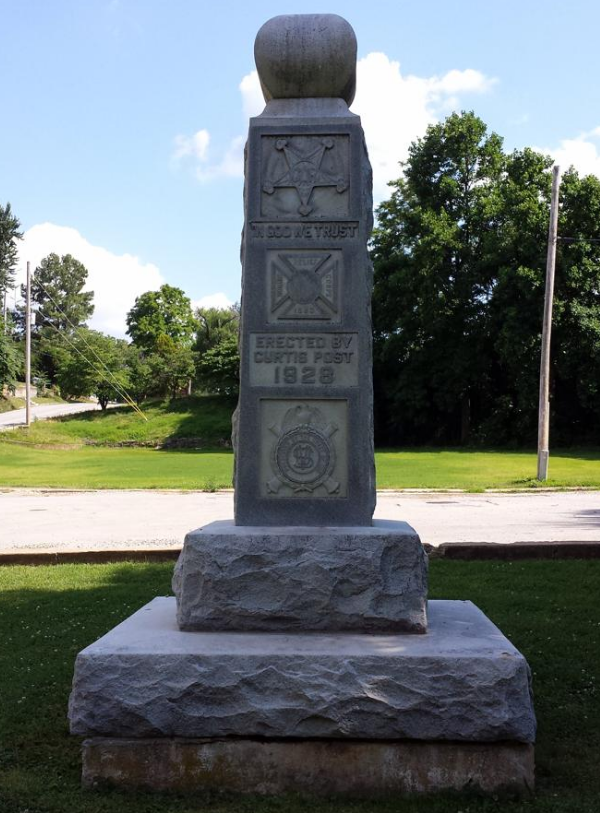
Multiple scholars have noted that "In God We Trust" motto is one of the main elements of civil religion in the United States.[129]
4.1. Religion
In Judaism and Christianity, the official motto "In God We Trust" is not found verbatim in any verses from the Bible, but the phrase is translated in similar terms in Psalm 91:2, in the Old Testament ("I will say of the LORD, He is my refuge and my fortress: my God; in him will I trust") and in the New Testament in 2 Corinthians 1:10 ("Who delivered us from so great a death, and doth deliver: in whom we trust that he will yet deliver us.") The concept is paraphrased in Psalm 118:8, Psalm 40:3, Psalm 73:28, and Proverbs 29:25.[130] According to Philip Jenkins, a historian of religion, some Bible translations rendered Psalm 56:11 as "In God I trust; I will not fear",[131] which could lead to substitution of the first "I" for "we".[4]
In Islam the word for the concept of reliance on God is called Tawakkul; the phrase "In God We Trust" is closely paraphrased in two places of the Quran, in surah 10 Yunus, as well as surah Al-A'raf (7:89), and several other verses reinforce this concept.[132] Melkote Ramaswamy, a Hindu American scholar, writes that the presence of the phrase "In God We Trust" on American currency is a reminder that "there is God everywhere, whether we are conscious or not."[133]
4.2. License Plates
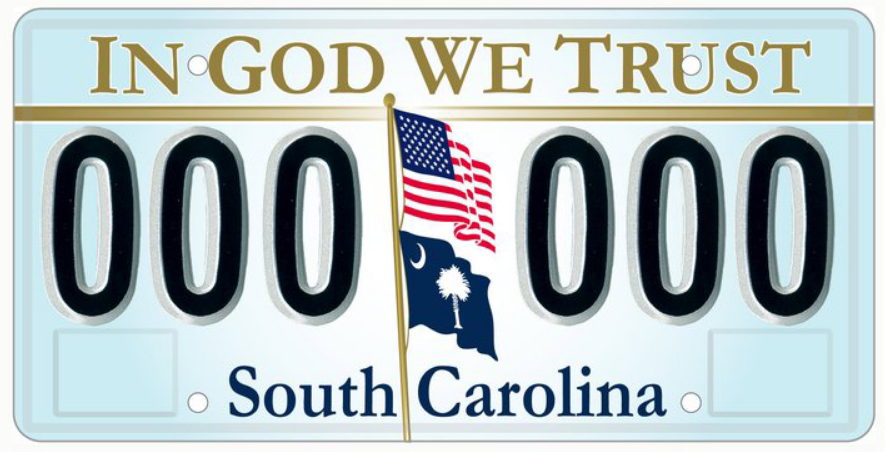
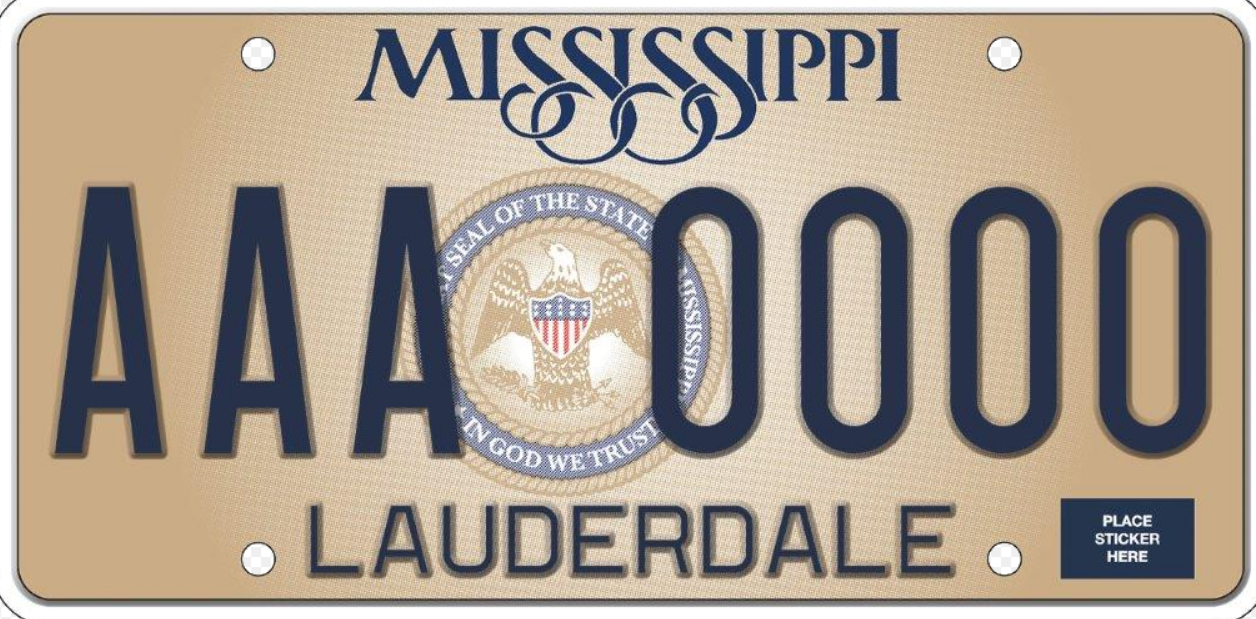
As of May 25, 2021, the following U.S. states currently offer an "In God We Trust" license plate (vanity and standard issues): Alaska, Arizona, Arkansas, Florida, Georgia, Indiana, Kansas , Kentucky, Louisiana, North Carolina, Ohio,[134] Oklahoma, Pennsylvania, South Carolina, Tennessee, Texas, Utah, Virginia, West Virginia, and Wisconsin.[135][136]
Among the states that use the motto in standard issues, the Mississippi's current standard plate features the motto as displayed on its state seal,[136][137] while Utah offers a standard option license plate.[138] Florida, which also offers a specialty plate, has an option to place "In God We Trust" instead of the official nickname or county name;[139] Georgia also provides for such an option,[140] while North Carolina offers an option with North Carolina's state motto and "In God We Trust" instead of "First in Flight" or "First in Freedom".[141] In Tennessee, the 2022 issue license plates will include the national motto if the license plate applicant asks to include it.[142]
4.3. Opinion Polls
According to a 2003 joint poll by USA Today, CNN, and Gallup, 90% of Americans support the inscription "In God We Trust" on U.S. coins.[143] MSNBC launched a similar live survey online that ran for several years in the late 2000s and yielded overwhelming opposition to the removal of the motto.[144] However, a more recent student poll in 2019 by College Pulse made for The College Fix showed that just over a half of students supports inclusion of the national motto in currency, with two-thirds of those who recognised themselves as Democrats opposing and 94% of Republicans in favor of the measure.[145]
5. Controversy
"In God We Trust" has long been controversial as an official motto due to what opponents perceive as being a religious statement, and as such, violating the separation of church and state. Secular and atheist organisations, such as Americans United for Separation of Church and State,[146][147] Freedom From Religion Foundation,[148][149] as well as The Satanic Temple[82] members, have all opposed inclusion of such motto. On the other hand, Project Blitz as well as conservative organisations and lawmakers have lobbied for its further adoption.[150][151]
Proponents have extensively argued for inclusion of the national motto in more settings, grounding it in the traditional invocations of God that they say have now become an element of a civil religion and should express the will of the founders, who believed in God.[11][72][152][153] Opponents, on the other hand, argue that not only does the motto violate the secular character of the United States, but it also predefines the type and number of gods (if any) to be trusted,[147][154][155] with some taking their arguments to the courts.
5.1. Litigation
The constitutionality of the phrase "In God We Trust" has been repeatedly upheld according to the judicial interpretation of accommodationism, whose adherents state that this entrenched practice has not historically presented any constitutional difficulty, is not coercive, and does not prefer one religious denomination over another.[156] In Zorach v. Clauson (1952), the Supreme Court also wrote that the nation's "institutions presuppose a Supreme Being" and that government recognition of God does not constitute the establishment of a state church as the Constitution's authors intended to prohibit.[157] The courts also rely on the notion of "ceremonial deism" (as defined in Brennan's dissent in Lynch v. Donnelly),[158] i.e. that there exist religious references that, through their repetitious and customary usage, have become secular and are thus constitutional.[159] While opponents of such rulings argue that Jefferson's notion of "wall of separation between church and state" prohibits any aid, direct or indirect, to any religious institution, and therefore any ruling to the contrary goes counter to Founders' intent, this separationist view has not gained significant ground in judicial settings.[156][160]
Even though not directly related to the motto, Engel v. Vitale elicited much speculation on the future of "In God We Trust" in public settings. In the ruling, the U.S. Supreme Court struck down a New York law that encouraged public schools to recite a prayer as written in state law on First Amendment grounds. The ruling sparked widespread outrage and was extremely unpopular at the time, even as the judges' decision was near-unanimous.[161] Almost 4/5 of Americans disapproved of the ruling, according to a Gallup poll.[162] Congressmen were afraid that "In God We Trust" would have to disappear from coins and banknotes,[163] the feeling shared by the then president of the American Bar Association, John C. Salterfield.[11] Senator Sam Ervin, a Democrat from North Carolina, went so far as to wonder if God was declared unconstitutional by that decision.[164] Congressmen tried to direct federal funds to buy Bibles for the Supreme Court justices and to propose a constitutional amendment allowing school prayer (both measures failed).[161] A similar ruling the following year in Abington Township v. Schempp prompted senators to attempt to force the Supreme Court to hang the national motto in the courtroom, which also did not succeed.[11]
Even though the Supreme Court has never ruled directly on the constitutionality of "In God We Trust",[165] several appellate federal courts and some state courts have, and the Supreme Court itself did not seem to have any problem with the phrase being inscribed on coins and banknotes.[33]
Aronow v. United States was the first case to challenge the inclusion of "In God We Trust" on United States dollar .[166] The passage of the statute that the lawsuit challenged ("the inscription 'In God we Trust'...shall appear on all United States currency and coins", 31 U.S.C. § 324a)[166] stood, and the Ninth Circuit stated that: "its [motto's] use is of patriotic or ceremonial character and bears no true resemblance to a governmental sponsorship of a religious exercise". In O'Hair v. Blumenthal (1978), the U.S. District Court for the Western District of Texas also upheld the law. A similar decision was reached on appeal to the Fifth Circuit in 1979, which affirmed that the "primary purpose of the slogan was secular".[30] The same decision was reached in Gaylor v. United States when it was appealed to the Tenth Circuit.[167]
A series of lawsuits attempting to outlaw "In God We Trust" was filed, with support of the Freedom From Religion Foundation, by Michael Newdow, who was known for his previous case Elk Grove Unified School District v. Newdow, in which the Ninth Circuit issued a ruling removing "under God" from the Pledge of Allegiance (the ruling was overturned by the U.S. Supreme Court). A federal judge in California rejected his reasoning in a June 2006 ruling, and the same conclusion was reached by the Ninth Circuit. Because the Supreme Court denied certiorari, the appellate court's decision, which said that "the national motto is of a "patriotic or ceremonial character," has no "theological or ritualistic impact," and does not constitute "governmental sponsorship of a religious exercise,"" remained unchanged and in force.[168] A lawsuit filed by Newdow and Freedom from Religion Foundation in 2013 in New York also failed, both on trial[169] and on appeal to the Second Circuit;[170] yet another one, filed in Ohio in 2016, was dismissed by the U.S. District Court for the Northern District of Ohio and the Sixth Circuit.[171] The same happened with the lawsuit in the Eighth Circuit, which was unrelated to Newdow's efforts.[172][173]
In 2015, David F. Bauman, a New Jersey state judge, dismissed a case against the Matawan-Aberdeen Regional School District brought by a student of the district and the American Humanist Association that argued that the phrase "under God" in the Pledge of Allegiance created a climate of discrimination because it promoted religion, making non-believers "second-class citizens".[174][175] He noted that "as a matter of historical tradition, the words 'under God' can no more be expunged from the national consciousness than the words 'In God We Trust' from every coin in the land, than the words 'so help me God' from every presidential oath since 1789, or than the prayer that has opened every congressional session of legislative business since 1787."[176]
Additionally, several courts have agreed that "In God We Trust" on public buildings did not violate the Establishment Clause: the New Hampshire Supreme Court[177] and the Fourth Circuit[178] did so for public schools, with the same appellate federal court arguing the same for a county government office.[179][180]
While efforts to remove "In God We Trust" were largely fruitless, in Wooley v. Maynard, the Supreme Court struck down a New Hampshire law mandating that every person carry the state motto on their license plates, noting that the state can't force its citizens to "use their private property as a 'mobile billboard' for the State's ideological message". In obiter dicta, the majority agreed that this "In God We Trust" lawsuit should not be construed to be a basis for challenge to the constitutionality of the motto on U.S. currency, which they argued was not something that was either associated directly with the owner or made to display.[33][181] Whether it is legal for Mississippi to issue standard license plates that display the national motto as it appears on the state seal (see above) and force drivers objecting to the invocation of God to pay for removing the reference is now being decided in a federal court.[182]
6. Usage in Other Countries
The Spanish equivalent of "In God We Trust", En Dios Confiamos, is an unofficial motto of the Republic of Nicaragua. The phrase can be seen on most of Nicaragua's coins.[183]
Additionally, the phrase has been used in heraldic settings. In 1860, the phrase was included in the coat of arms of New Westminster, British Columbia, and it stayed there ever since.[184][185] Also, until 1997, the heraldic motto of Brighton, England was the Latin equivalent of the phrase, In Deo Fidemus.[186][187]
References
- "Founders Online: Colors of the Associator Companies, 12 January 1748 and 16 April 1748" (in en). http://founders.archives.gov/documents/Franklin/01-03-02-0105.
- Popik, Barry (2009-07-02). "In God we trust (all others pay cash)" (in en). https://www.barrypopik.com/index.php/new_york_city/entry/in_god_we_trust_all_others_pay_cash.
- Shapiro, Fred Q. (2006). The Yale Book of Quotations. New Haven, Ct.: Yale University Press. pp. 145. ISBN 9780300107982.
- Kidd, Thomas S. (2015-11-10). "The Origin of "In God We Trust"" (in en). https://www.patheos.com/blogs/anxiousbench/2015/11/the-origin-of-in-god-we-trust/.
- Watt's Psalter, 1785. June 2006. https://quod.lib.umich.edu/e/evans/N14926.0001.001/1:4.261?rgn=div2;view=fulltext. Retrieved 2021-10-31.
- Chase, Salmon P (1863-12-09). Letter to James Pollock. National Archives and Records Administration. p. 11.
- Dominguez, André. ""In God We Trust" originated from a Columbia County President Judge". https://colcohist-gensoc.org/wp-content/uploads/117trust.pdf.
- Popik, Barry (2009-07-02). "In God we trust (all others pay cash)" (in en). https://www.barrypopik.com/index.php/new_york_city/entry/in_god_we_trust_all_others_pay_cash.
- "The Liberator. v.15:no.17(1845:Apr.25)". https://www.digitalcommonwealth.org/book_viewer/commonwealth:gb19h269f.
- Latterell, Justin (2015-04-21). "In God We Trust: Abraham Lincoln and America's Deathbed Repentance" (in en). Political Theology 12 (4): 594–607. doi:10.1558/poth.v12i4.594. https://dx.doi.org/10.1558%2Fpoth.v12i4.594
- Lienesch, Michael (May 2019). ""In God We Trust:" The U.S. National Motto and the Contested Concept of Civil Religion" (in en). Religions 10 (5): 340. doi:10.3390/rel10050340. https://dx.doi.org/10.3390%2Frel10050340
- Disney, David T. (February 1845). "Bro. Disney's Address". The Ark, and Odd Fellows Magazine 2 (2): 20, 184. https://books.google.com/books?id=uBcZAAAAYAAJ&q=%22in+god+we+trust%22&pg=PA20. Retrieved 2021-06-19.
- "History of 'In God We Trust'" (in en-us). 2011. https://www.treasury.gov/about/education/Pages/in-god-we-trust.aspx.
- Myers, R. Andrew (2020-07-25). "How did "In God We Trust" come to be on American currency? A 19th-century Presbyterian played a major role" (in en). https://www.logcollegepress.com/blog/2020/7/24/how-did-in-god-we-trust-come-to-be-on-american-currency-a-19th-century-presbyterian-played-a-major-role.
- Annual Report of the Secretary of the Treasury on the State of the Finances for the Year 1896. Washington: United States Government Printing Office. 1897. pp. 260. https://books.google.com/books?id=Yv0qAAAAYAAJ&pg=PA260. Retrieved 2021-08-07.
- See preamble of CSA Constitution: ...invoking the favor and guidance of Almighty God...
- Begley, Sarah (2016-01-13). "How 'In God We Trust' Got on the Currency in the First Place" (in en). Time. https://time.com/4179685/in-god-we-trust-currency-history/. Retrieved 2021-05-24.
- For sources discussing it, see:Alexander, Ted (2011). The Battle of Antietam: The Bloodiest Day. Charleston, S.C.: The History Press. pp. 76. ISBN 978-1-60949-179-6. 125th PA Vol. Infantry: IN GOD WE TRUST. WTAJ (Television production). 2012-06-28. Archived from the original on 2016-08-10. Retrieved 2016-11-29 – via YouTube."Antietam: 125th Pennsylvania Infantry". https://antietam.aotw.org/officers.php?unit_id=269. Pennsylvania Infantry. 125th Regiment, 1862–1863 (2009). History Of The One Hundred And Twenty-fifth Regiment, Pennsylvania Volunteers, 1862–1863. Ithaca, N.Y.: Cornell University Library. pp. 150–152. ISBN 978-1-112-13570-5.
- "A descriptive list of the Confederate flags in the possession of the State Historical Society of Iowa". 1918. p. 4. https://babel.hathitrust.org/cgi/pt?id=mdp.39015070233708&view=1up&seq=10. "Bunting, 4x7 feet (modified form of Stars and Bars), Union blue with twelve 8-point stars in circle. "In God We Trust" printed on white silk and stitched on white bar of Field. No record of when or where captured."
- Dedmondt, Glenn (2009) (in en). The Flags of Civil War Arkansas. Pelican Publishing. pp. 108–109. ISBN 978-1-4556-0432-6. https://books.google.com/books?id=KCAxwqU1oAEC&dq=iowa+confederate+flag+in+god+we+trust&pg=PA108.
- Taylor, William D. (2008) (in en). "A Fit Representation of Pandemonium": East Tennessee Confederate Soldiers in the Campaign for Vicksburg. Mercer University Press. pp. 302. ISBN 978-0-88146-034-6. https://books.google.com/books?id=zPTY56TRFxUC&dq=iowa+confederate+flag+in+god+we+trust&pg=PA302.
- "Sketches of the Metropolitan Fair". Harper's Weekly 8: 261. 1864-04-23. https://archive.org/details/harpersweeklyv8bonn/page/260/mode/2up. Retrieved 2021-05-29.
- Cunningham, Sumner Archibald (January 1896). "Flag History" (in en). Confederate Veteran (Nashville): 117. https://books.google.com/books?id=DSNEAQAAMAAJ&pg=PA117.
- Jr, John J. Pitney (2001-09-01) (in en). The Art of Political Warfare. University of Oklahoma Press. pp. 91. ISBN 978-0-8061-3382-9. https://books.google.com/books?id=7OPmKnf3jywC&dq=confederate+flag+in+god+we+trust&pg=PA91.
- Harp, Gillis J. (2019-08-02) (in en). Protestants and American Conservatism: A Short History. New York: Oxford University Press. pp. 95–96. ISBN 978-0-19-997741-3. https://books.google.com/books?id=WCeeDwAAQBAJ. Retrieved 2021-06-19.
- "Adopting In God We Trust as the U.S. National Motto". Journal of Church and State 44 (4): 682–83. 2002. doi:10.1093/jcs/44.4.671. https://heinonline.org/HOL/Page?handle=hein.journals/jchs44&id=685&collection=journals&index=. (Referencing H. Rept. No. 1959, 84th Cong., 2d Sess. (1956) and S. Rept. No. 2703, 84th Cong., 2d Sess. (1956), 2.)
- Breen, Walter (1988). Walter Breen's Complete Encyclopedia of U.S. and Colonial Coins.. New York: Doubleday. pp. 238, 353, 572–573. ISBN 978-0-385-14207-6.
- According to the Congressional Record (1908, U.S. House of Representatives), p. 3387, the motto was adopted "doubtless with his [Lincoln's] knowledge and approval".
- 102 Congressional Record – Senate. Washington, D.C.. 1956. pp. 13917. http://www.nonbeliever.org/images/CR102-13917.pdf. Retrieved 2021-08-09.
- Duncan, Ann W. (2007-12-30) (in en). Church-state Issues in America Today. 1. Westport, Ct.: Praeger Publishers. pp. 88. ISBN 978-0-275-99367-2. https://books.google.com/books?id=-6kZHs0yG5sC&q=Church-state+Issues+in+America+Today. Retrieved 2021-06-19.
- Giedroyc, Richard. "Two Cent" (in en-us). https://www.pcgs.com/coinfacts/category/two-cent-1864-1873/670.
- Lange, David W. (2005). History of the United States Mint and its Coinage. Whitman Publisher LLC. pp. 98–99. ISBN 978-0794819729.
- Ackerman, David M. (1996-07-10). ""In God We Trust" on the Nation's Coins and Currency and as the National Motto: History and Constitutionality". https://www.everycrsreport.com/files/19960710_96-609_a80750766297a603d32b12e9f6d72db35ab6ac04.pdf.
- Mislin, David. "The complex history of 'In God We Trust'" (in en). http://theconversation.com/the-complex-history-of-in-god-we-trust-91117.
- "Type 2, No Motto" (in en-us). https://www.pcgs.com/coinfacts/category/gold-coins/st-gaudens-20-1907-1933/type-2-no-motto-1907-1908/784.
- "20 Dollars, Compound Interest Treasury Note, United States, 1864" (in en). https://americanhistory.si.edu/collections/search/object/nmah_1876617.
- "20 Dollars, Interest Bearing Note, United States, 1864" (in en). https://americanhistory.si.edu/collections/search/object/nmah_1876647.
- "THE NEW LEGEND ON OUR COINS." (in en-US). The New York Times. 1865-12-18. ISSN 0362-4331. https://www.nytimes.com/1865/12/18/archives/the-new-legend-on-our-coins.html.
- "The New Five Cent Piece. [Communicated]". American Journal of Numismatics, and Bulletin of the American Numismatic and Archaeological Society 1 (4): 27. 1866. ISSN 2381-4586. https://www.jstor.org/stable/43585592. Retrieved 2021-06-01.
- "In God We Trust; All Others Cash" (in en-US). 2017-12-10. https://quoteinvestigator.com/2017/12/10/cash/.
- Garret, Jeff; Guth, Ron (2008). Encyclopedia of U.S. Gold Coins, 1795–1933 (2nd ed.). Atlanta: Whitman Publishing. pp. 476. ISBN 978-0-7948-2254-5.
- "100 Greatest U.S. Coins". https://www.collectors.com/setmatch/setmatchdetail?compitemid=54748&itemtypeid=1&compid=1576&exactmatch=True&hidenomatch=False&hidehascurrentitem=False&days=Any&lowgrade=Any&highgrade=Any&lowprice=Any&highprice=Any&sellerexclude=false.
- Gatewood, Willard B. (1966). "Theodore Roosevelt and the Coinage Controversy". American Quarterly 18 (1): 35–51. doi:10.2307/2711109. ISSN 0003-0678. https://dx.doi.org/10.2307%2F2711109
- Burdette, Roger W. (2006). Renaissance of American Coinage, 1905–1908. Great Falls, Va.: Seneca Mill Press. pp. 193–195. ISBN 978-0-9768986-1-0.
- "10 Interesting Facts About Theodore Roosevelt". Republicanpresidents.net. 2009-03-04. http://www.republicanpresidents.net/10-interesting-facts-about-theodore-roosevelt/.
- Merriman, Scott A. (2007). Religion and the Law in America: An Encyclopedia of Personal Belief and Public Policy. Santa Barbara, Calif.: ABC-CLIO. ISBN 978-1851098637. https://books.google.com/books?id=l_8VFygyaDYC&pg=PA281. Retrieved 2021-08-09. "In 1956, the United States, changed its motto to 'In God We Trust', in large part to differentiate itself from the Soviet Union, its Cold War enemy that was widely seen as promoting atheism."
- Kruse, Kevin M. (2015). One Nation Under God: How Corporate America Invented Christian America. New York: Basic Books. pp. xiv-xv. ISBN 978-0-465-04949-3.
- Herzog, Jonathan P. (2011-08-05) (in en). The Spiritual-Industrial Complex: America's Religious Battle Against Communism in the Early Cold War. New York: Oxford University Press, USA. pp. 97, 101. ISBN 978-0-19-539346-0. https://books.google.com/books?id=pGC8D-ybQnAC&q=Louis+C.+Rabaut+postage+cancellation+god+we+trust&pg=PA101. Retrieved 2021-06-19.
- Jain, Kalpana (2021-06-11). "Why the legacy of Billy Graham continues to endure: 3 essential reads" (in en). http://theconversation.com/why-the-legacy-of-billy-graham-continues-to-endure-3-essential-reads-162465.
- "NEW STAMP GETS MOTTO; 'In God We Trust' 8-Center to Go on Sale Early in April" (in en-US). The New York Times. 1954-02-26. ISSN 0362-4331. https://www.nytimes.com/1954/02/26/archives/new-stamp-gets-motto-in-god-we-trust-8center-to-go-on-sale-early-in.html.
- Christopher, West (2014). A History of America in Thirty-Six Postage Stamps. London: Picador. pp. 232. ISBN 978-1250043689.
- Cep, Casey N. (2014-02-20). "When Did Americans Start Trusting in God?" (in en). https://psmag.com/news/americans-start-trusting-god-74456.
- "The legislation placing "In God We Trust" on national currency | US House of Representatives: History, Art & Archives". history.house.gov. 1955-07-11. http://history.house.gov/Historical-Highlights/1951-2000/The-legislation-placing-%E2%80%9CIn-God-We-Trust%E2%80%9D-on-national-currency/.
- "United States Currency Inscription" (in en). Miscellaneous Hearings: Hearings Before ... , 84-1 on H.J.Res. 202 ... , H.R. 3327 ... , H.R. 619 ... 1956. Washington, D.C.: United States Congress House Banking and Currency Committee. 1956. pp. 47–57. https://books.google.com/books?id=dEADWZdN2k8C&q=strengthen+our+freedom&pg=PA47. Retrieved 2021-08-11.
- Fitschen, Steve (2018-02-11). "Defending "In God We Trust"" (in en-US). https://nationallegalfoundation.org/briefings/defending-in-god-we-trust/.
- "Congressional Record, Volume 148 Issue 105 (Monday, July 29, 2002)". https://www.govinfo.gov/content/pkg/CREC-2002-07-29/html/CREC-2002-07-29-pt1-PgE1437-2.htm. "The following year, 1955, largely at the instigation of Matt Rothert, later president of the American Numismatic Association, Congress amended the U.S. Code to require the national motto to be placed on all coins and currency."
- "An Act to provide that all United States currency shall bear the inscription "In God We Trust."". 1955-07-11. https://www.govinfo.gov/content/pkg/STATUTE-69/pdf/STATUTE-69-Pg290-2.pdf.
- "The Legislation Placing "In God We Trust" on National Currency'". United States House of Representatives.
- Not produced since 1971
- Merriman, Scott A. (2007) (in en). Religion and the Law in America: An Encyclopedia of Personal Belief and Public Policy. 1. Santa Barbara, Calif.: ABC-CLIO. pp. 281. ISBN 978-1-85109-863-7. https://books.google.com/books?id=l_8VFygyaDYC&pg=PA281. Retrieved 2016-12-16.
- Epstein, Steven B. (1996). "Rethinking the Constitutionality of Ceremonial Deism". Columbia Law Review 96 (8): 2083–2174. doi:10.2307/1123418. ISSN 0010-1958. https://www.jstor.org/stable/1123418.
- Quoting the peroration (abridged here) of the speech by Charles Edward Bennett, sponsor in the House, the only speech in either House of Congress on the subject. President Eisenhower and W. Randolph Burgess, Deputy to the Treasury for Monetary Affairs, had approved of the legislation. 101 Congressional Record pp. 4384 (quoted), 7796. (1955)
- Margaret Wood (2013-04-22). "In God We Trust". Library of Congress. https://blogs.loc.gov/law/2013/04/in-god-we-trust/.
- "New National Motto Of U. S. Recalls Key's Words Of 1814" (in en). Palladium-Item (Richmond, Indiana): p. 8. 1956-08-13. https://www.newspapers.com/newspage/249484657/?terms=in+god+we+trust.
- Miller, Douglas; Marion, Nowak (1977). The Fifties: The Way We Really Were. Doubleday. pp. 89. "'In God We Trust' was adopted as the national motto in 1956, with neither debate nor a single dissenting vote in the House or Senate."
- For the relevant statutes, see 36 U.S.C. § 302 and United States Public Law 84-851 https://www.law.cornell.edu/uscode/text/36/302
- Bittker, Boris; Idleman, Scott; Ravitch, Frank (2015). Religion and the State in American Law. Cambridge University Press. p. 136. ISBN 9781107071827. https://books.google.com/books?id=pduCCgAAQBAJ&q=%22e+pluribus+unum%22+1776+motto&pg=PA136. Retrieved 2020-11-12.
- Felicia Sonmez (2011-11-01). "Social issues return to fore with 'In God We Trust' resolution". The Washington Post. https://www.washingtonpost.com/blogs/2chambers/post/social-issues-return-to-fore-with-in-god-we-trust-resolution/2011/10/31/gIQAXQasZM_blog.html. "'In 2006, on the 50th anniversary of its adoption, the Senate reaffirmed 'In God We Trust' as the official national motto of the United States,' Forbes said in a statement announcing the vote. 'Tomorrow, the House of Representatives will have the same opportunity to reaffirm our national motto and directly confront a disturbing trend of inaccuracies and omissions, misunderstandings of church and state, rogue court challenges, and efforts to remove God from the public domain by unelected bureaucrats.'"
- Jennifer Steinhauer (2011-11-03). "In God We Trust, With the House's Help". The New York Times. https://www.nytimes.com/2011/11/02/us/house-of-representatives-affirms-in-god-we-trust-motto.html. "Citing a crisis of national identity and mass confusion among Americans about their nation's motto, the House on Tuesday voted on a resolution 'reaffirming "In God We Trust" as the official motto of the United States.'"
- Todd Starnes (2011-11-03). "See Which Congressmen Voted Against 'In God We Trust'". Fox News. http://nation.foxnews.com/congress/2011/11/01/see-which-congressmen-voted-against-god-we-trust#ixzz1cYiMXHil. "The House of Representatives passed a bi-partisan resolution Tuesday night reaffirming "In God We Trust" as the official motto of the United States. The 396–9 vote came at the request of Rep. Randy Forbes (R-VA)."
- "House Votes For Display Of 'in God We Trust' Motto In Public Buildings" (in en). 2000-07-23. https://www.au.org/media/press-releases/house-votes-for-display-of-in-god-we-trust-motto-in-public-buildings.
- "H. Res. 548 Engrossed in House". https://www.govinfo.gov/content/pkg/BILLS-106hres548eh/html/BILLS-106hres548eh.htm.
- "Furniture | US House of Representatives: History, Art & Archives" (in en). https://history.house.gov/Exhibitions-and-Publications/Capitol/1951-Present/Furniture/.
- "Florida State Motto In God We Trust". http://www.netstate.com/states/mottoes/fl_motto.htm.
- "State Motto". http://dos.myflorida.com/florida-facts/florida-state-symbols/state-motto/.
- "The 2020 Florida Statutes: 15.0301". http://www.leg.state.fl.us/Statutes/index.cfm?App_mode=Display_Statute&Search_String=&URL=0000-0099/0015/Sections/0015.0301.html. "State motto.—"In God We Trust" is hereby designated and declared the official motto of the State of Florida."
- "State Seal". https://dos.myflorida.com/florida-facts/florida-state-symbols/state-seal/.
- "State Flag". https://dos.myflorida.com/florida-facts/florida-state-symbols/state-flag/.
- Smith, Whitney (2004-03-25). "Flag of Georgia | United States state flag" (in en). https://www.britannica.com/topic/flag-of-Georgia-United-States-state-flag.
- "Mississippi Religious Freedom Restoration Act; enact and modify the great seal.". Senate Bill No. 2681. Jackson, Miss.: Mississippi Legislature. January 2014. http://billstatus.ls.state.ms.us/documents/2014/pdf/SB/2600-2699/SB2681PS.pdf.
- Wagster Pettus, Emily (2014-01-31). "Miss. Senate OKs adding 'In God We Trust' to seal". Jackson Free Press. https://www.jacksonfreepress.com/news/2014/feb/01/miss-senate-oks-adding-god-we-trust-seal/.
- Knowles, Lindsay (2020-07-08). "Satanic Temple threatens lawsuit if 'In God We Trust' appears on new Mississippi flag" (in en-US). https://www.wlbt.com/2020/07/08/satanic-temple-threatens-lawsuit-if-god-we-trust-appears-new-mississippi-flag/.
- "Mississippi governor signing law for flag without rebel sign" (in en). 2021-01-11. https://www.independent.co.uk/news/world/americas/us-politics/mississippi-governor-signing-law-for-flag-without-rebel-sign-flag-mississippi-flag-us-confederate-b1785655.html.
- "'In God We Trust' Posters to Be Displayed in Arkansas Public Schools". 2018-03-12. https://insider.foxnews.com/2018/03/12/god-we-trust-posters-be-displayed-arkansas-public-schools-after-donations.
- Perozek, Dave (2018-03-11). "Some Arkansas schools will display 'In God we trust' after posters donated". https://www.arkansasonline.com/news/2018/mar/11/schools-will-display-in-god-we-trust-20/.
- "Display of National Motto in Public Schools". September 2019. https://www.ncsl.org/Portals/1/Documents/educ/In_God_We_Trust.pdf?ver=2019-10-22-113444-580×tamp=1571765698383.
- Sterling, Joe. "Florida lawmakers advance a bill that requires 'In God We Trust' displayed on school grounds". https://edition.cnn.com/2018/02/23/us/florida-in-god-we-trust-legislation-trnd/index.html.
- "Florida lawmakers advance bill that would require 'In God We Trust' to be visible on all school buildings". 2018-02-23. http://www.newsweek.com/florida-lawmakers-give-go-ahead-bill-have-god-we-trust-school-buildings-818745.
- "Atheist group offers to provide "In God We Trust" signs to Florida public schools". 2018-03-26. https://www.tampabay.com/blogs/gradebook/2018/03/26/atheist-group-offers-to-provide-in-god-we-trust-signs-to-florida-public-schools/.
- Balingit, Moriah (2018-12-01). "Does 'In God We Trust' belong in schools? More and more states say yes." (in en-US). The Washington Post. ISSN 0190-8286. https://www.washingtonpost.com/local/education/does-in-god-we-trust-belong-in-schools-more-and-more-states-say-yes/2018/12/01/d846f870-e863-11e8-b8dc-66cca409c180_story.html.
- "HOUSE CONCURRENT RESOLUTION 32" (in en-US). https://legislature.idaho.gov/sessioninfo/2020/legislation/hcr032/.
- "7.090 Legislative Research Commission – Kentucky". https://apps.legislature.ky.gov/law/statutes/statute.aspx?id=43315.
- "Display of national motto in public elementary and secondary schools – Reading and posting in public schools of texts and documents on American history and heritage.". 2019-06-27. https://apps.legislature.ky.gov/law/statutes/statute.aspx?id=48792.
- Wood, Josh (2019-09-13). "'In God We Trust': display in Kentucky schools marks effort to mix church and state" (in en). http://www.theguardian.com/us-news/2019/sep/12/in-god-we-trust-display-in-kentucky-schools-marks-effort-to-mix-church-and-state.
- "'In God We Trust' found in form of dollar bill at Fayette County schools". 2019-08-14. https://www.wkyt.com/content/news/In-God-We-Trust-found-in-form-of-dollar-bill-at-Fayette-County-school-542607641.html.
- Rand, Brendan (2019-08-13). "Louisiana public schools will display 'In God We Trust' beginning this school year" (in en). https://abcnews.go.com/US/louisiana-public-schools-display-god-trust-beginning-school/story?id=64947756.
- Kelly McCleary (2019-08-11). "'In God We Trust' signs to greet Louisiana students in new school year". https://edition.cnn.com/2019/08/11/us/in-god-we-trust-louisiana-schools/index.html.
- Torres, Ella (2019-07-26). "South Dakota public schools now required to display 'In God We Trust' on walls" (in en). https://abcnews.go.com/US/south-dakota-public-schools-now-required-display-god/story?id=64587406.
- "SENATE BILL NO. 224". https://www.legis.la.gov/legis/ViewDocument.aspx?d=1101373.
- "National News Briefs; 'In God We Trust' Motto For Mississippi Schools". The New York Times. Associated Press. 2001-03-25. https://www.nytimes.com/2001/03/25/us/national-news-briefs-in-god-we-trust-motto-for-mississippi-schools.html.
- "New Ohio Law Requires Schools to Display "In God We Trust"" (in en-US). 2006-07-17. https://www.lc.org/newsroom/details/071706-new-ohio-law-requires-schools-to-display-in-god-we-trust.
- Matias, Dani (2019-07-25). "South Dakota Public Schools Add 'In God We Trust' Signs To Walls" (in en). https://www.npr.org/2019/07/25/744909500/south-dakota-public-schools-add-in-god-we-trust-signs-to-walls.
- "'In God We Trust' going up at South Dakota public schools". 2019-07-24. https://apnews.com/article/7fee63ffb2f14a3698815490325a9fc6.
- "Bill Title: Require the national motto of the United States to be displayed in public schools.". https://legiscan.com/SD/text/SB55/id/1945148.
- Meyer, Holly. "Tennessee lawmakers pass bill requiring public schools to post 'In God We Trust' motto". https://www.tennessean.com/story/news/religion/2018/03/21/tennessee-lawmakers-pass-bill-requiring-public-schools-post-god-we-trust-motto/442884002/.
- Constantine, Mary. "'In God We Trust' motto now required to be displayed in all Tennessee public schools" (in en-US). https://www.knoxnews.com/story/news/education/2018/08/03/god-we-trust-motto-tennessee-public-schools/889966002/.
- Kelley, Bryan. "'In God We Trust': Public School Displays of the National Motto" (in en-US). https://ednote.ecs.org/in-god-we-trust-public-school-displays-of-the-national-motto/.
- "Government Legislature". https://ingodwetrust.com/get-involved/government-legislature/.
- Bohra, Neelam (2021-05-24). "Some Texas schools would be required to hang "In God We Trust" signs under measure nearing passage by lawmakers" (in en). https://www.texastribune.org/2021/05/24/texas-school-signs-legislature/.
- Herman, Ken (2021-05-27). "Herman: Legislature says non-school groups should be allowed to force posting of "In God We Trust"" (in en-US). https://www.statesman.com/story/news/columns/2021/05/26/herman-legislature-says-non-school-groups-should-allowed-force-posting-in-god-we-trust/7428751002/.
- Helderman, Rosalind S.; Samuels, Christina A. (2002-06-28). "Va. Schools Forge Ahead With National Motto" (in en-US). The Washington Post. ISSN 0190-8286. https://www.washingtonpost.com/archive/local/2002/06/28/va-schools-forge-ahead-with-national-motto/c1a2521b-73d8-4b54-87b0-7bbd2b30e599/.
- "2002 Uncodified Acts – Chapter 895". 2002-05-17. https://law.lis.virginia.gov/uncodifiedacts/2002/session1/chapter895/.
- Tanner, Courtney (2019-07-27). "Utah has required schools to have 'In God We Trust' posted publicly for 17 years" (in en-US). https://sltrib.com/news/2019/07/27/utah-has-required-schools.
- "53G-10-302. Instruction in American history and government – Study and posting of American heritage documents.". https://le.utah.gov/xcode/Title53G/Chapter10/53G-10-S302.html.
- Schleisman, Nicolette (2018-08-21). "New Alabama law allows "In God We Trust" in public schools" (in en-US). https://www.wkrg.com/mobile-county/new-alabama-law-allows-in-god-we-trust-in-public-schools/.
- Pyeatt, Matt (2002-01-03). "Michigan government offices now urged to display 'In God We Trust' – Baptist Press" (in en-US). https://www.baptistpress.com/resource-library/news/michigan-government-offices-now-urged-to-display-in-god-we-trust/.
- Rayno, Garry (2021-05-13). "Senate Sends Bills Changing Public Education To Governor" (in en-US). http://indepthnh.org/2021/05/13/senate-sends-bills-changing-public-education-to-governor/.
- "New Hampshire Legislature protects display of mottos" (in en). 2021-06-10. https://apnews.com/article/nh-state-wire-new-hampshire-legislature-57dc2ca53e1b453a968d3f86d8d587a0.
- "Governor Chris Sununu Signs 23 Bills Into Law, Vetoes 2" (in en). 2021-07-30. https://www.governor.nh.gov/news-and-media/governor-chris-sununu-signs-23-bills-law-vetoes-2.
- DiStaso, John (2021-08-07). "NH Primary Source: Democrats, Republicans spar over bill prohibiting restrictions on display of state, national mottos". https://www.wmur.com/article/nh-primary-source-democrats-republicans-spar-over-bills-prohibiting-restrictions-on-display-of-state-national-mottos/37226390.
- "Bill No. 2477 (An Act relating to schools)". http://webserver1.lsb.state.ok.us/cf_pdf/2003-04%20ENR/hB/HB2477%20ENR.PDF.
- "Oklahoma SB1016 | 2018 | Regular Session" (in en). https://legiscan.com/OK/bill/SB1016/2018.
- "South Carolina Code of Laws. Title 10 – Public Buildings and Property". https://www.scstatehouse.gov/code/t10c001.php.
- Daniel, Rae (2015-08-01). "'In God We Trust' stickers placed on Jefferson Co., IL squad cars" (in en). https://www.kfvs12.com/story/29683669/in-god-we-trust-to-be-placed-on-jefferson-co-il-squad-cars.
- "Atheist Group Asks Police Remove 'In God We Trust' Car Decal". 2015-10-01. http://dailysignal.com/2015/10/01/atheist-group-calls-for-removal-of-in-god-we-trust-police-car-decals-police-chief-says-go-fly-a-kite/.
- Sam, Morgan (2019-06-06). "'In God We Trust' decals to be placed on local police, fire vehicles". The Bakersfield Californian. https://www.bakersfield.com/news/in-god-we-trust-decals-to-be-placed-on-local/article_fb214930-880a-11e9-9042-03579af67a08.html.
- "Home" (in en-US). https://ingodwetrustamerica.org/.
- Howlett, Debbie (2002-02-19). "'In God We Trust' pressed for schools". USAToday. http://usatoday30.usatoday.com/news/nation/2002/02/20/usat-posters.htm.
- For various perspectives on the matter, see:Latterell, Justin (2015-04-21). "In God We Trust: Abraham Lincoln and America's Deathbed Repentance" (in en). Political Theology 12 (4): 594–607. doi:10.1558/poth.v12i4.594. Bellah, Robert N. (1967). "Civil Religion in America". Daedalus 96 (1): 1–21. ISSN 0011-5266. https://www.jstor.org/stable/20027022. Retrieved 2021-05-26. "In God We Trust: Civil and Uncivil Religion in America" (in en-AU). 1999-10-26. https://www.abc.net.au/radionational/programs/archived/encounter/in-god-we-trust-civil-and-uncivil-religion-in/3560790. Fait, Stefano. "Civil Religion" (in en). https://www.mtsu.edu/first-amendment/article/1519/civil-religion. Knicely, James J.; Whitehead, John W. (2010). "In God We Trust: The Judicial Establishment of American Civil Religion". John Marshall Law Review 43. https://repository.law.uic.edu/cgi/viewcontent.cgi?article=1097&context=lawreview. Retrieved 2021-05-26. Coleman, John A. (1970-07-01). "Civil Religion". Sociology of Religion 31 (2): 75. doi:10.2307/3710057.
- "In God We Trust: The Motto". All About History. http://www.allabouthistory.org/in-god-we-trust.htm.
- "The Scottish Metrical Psalter". http://www.cgmusic.org/workshop/smp_frame.htm.
- "Verses including the word Putting One's Trust in Allah (Tawakkul)". Quran Index. http://quranindex.net/kelime.php?id=8603.
- Ramaswamy, Melkote (2012-08-11). "Faith/Values | Indianapolis Star". indystar.com. http://www.indystar.com/article/20120811/LIFE04/208110323/In-Hinduism-there-just-one-God-many-forms.
- "4503.763 Ohio Battleflag license plates.". Lawriter LLC. http://codes.ohio.gov/orc/4503.763. ""Ohio Battleflag" license plates shall be inscribed with the words "In God We Trust""
- "Project Blitz – "In God We Trust" License Plates" (in en-US). https://www.blitzwatch.org/in-god-we-trust-license-plates.
- Parke, Caleb (2019-01-03). "Mississippi unveils new state license plates with 'In God We Trust'" (in en-US). https://www.foxnews.com/us/mississippis-new-license-plates-say-in-god-we-trust.
- "Mississippi adding 'In God We Trust' on new license plate". 2019-01-01. https://apnews.com/article/09cd7d3c984a43478431840d2280a227.
- "In God We Trust – Utah". https://dmv.utah.gov/plates/united.
- "License Plates & Registration" (in en). https://www.flhsmv.gov/motor-vehicles-tags-titles/license-plates-registration/.
- "2019 Georgia Code :: Title 40 – Motor Vehicles and Traffic :: Chapter 2 – Registration and Licensing of Motor Vehicles :: Article 1 – General Provisions :: § 40-2-9. Space for county name decal; display of "In God We Trust" decal in lieu of county name decal" (in en). https://law.justia.com/codes/georgia/2019/title-40/chapter-2/article-1/section-40-2-9/.
- Stradling, Richard (2019-07-01). "'In God We Trust' now an option on your next North Carolina license plate". The News & Observer. https://www.newsobserver.com/news/local/article232138912.html.
- Medina, Daniella. "Exclusive: Designer explains how we ended up with those 4 options for Tennessee's new license plate" (in en-US). https://www.tennessean.com/story/news/local/2021/09/24/tennessee-license-plate-design-speak-creative/5830623001/.
- "USA TODAY/CNN/Gallup Poll results". USA Today. 2011. https://www.usatoday.com/news/polls/tables/live/2003-09-29-religion-poll.htm. "C. The inscription "In God We Trust" on U.S. coins; 2003 Sep 19–21; Approve 90; Disapprove 8; No opinion 2"
- Mikkelson, David (2009-10-28). "NBC Belief in God Poll" (in en-US). https://www.snopes.com/fact-check/god-poll/.
- Kabbany-Fix, Jennifer (2019-08-28). "Nearly half of college students believe 'In God We Trust' should be removed from U.S. currency: poll". https://www.thecollegefix.com/nearly-half-of-college-students-believe-in-god-we-trust-should-be-removed-from-u-s-currency-poll/.
- Sokol, Samantha (2020-07-02). "Mississippi Trades Confederate Emblem For 'In God We Trust' On State Flag" (in en). https://www.au.org/blogs/mississippi-new-flag.
- Boston, Rob (2019-01-25). "If 'In God We Trust' Isn't Really A Religious Statement, Then What Exactly Is It?" (in en). https://www.au.org/blogs/wall-of-separation/if-in-god-we-trust-isnt-really-a-religious-statement-then-what-exactly-is.
- Nachreiner-Mackesey, Bailey. "TAKE ACTION: "In God We Trust" bill has passed the Ill. House – Freedom From Religion Foundation" (in en-gb). https://ffrf.org/news/action/item/38783-take-action-in-god-we-trust-bill-has-passed-the-ill-house.
- Nachreiner-Mackesey, Bailey. "Take Action: N.H. lawmakers advance 'In God We Trust' in schools – Freedom From Religion Foundation" (in en-gb). https://ffrf.org/news/action/item/38715-take-action-n-h-lawmakers-advance-in-god-we-trust-in-schools.
- "Project Blitz – "In God We Trust" Displays in Schools" (in en-US). https://www.blitzwatch.org/in-god-we-trust-school-displays.
- Taylor, David (2019-01-14). "'In God We Trust' – the bills Christian nationalists hope will 'protect religious freedom'" (in en). http://www.theguardian.com/us-news/2019/jan/14/christian-nationalists-bills-religious-freedom-project-blitz.
- Foster, Thomas A. (2011-11-09). ""In God We Trust" or "E Pluribus Unum"? The American Founders Preferred the Latter Motto | Origins: Current Events in Historical Perspective". https://origins.osu.edu/history-news/god-we-trust-or-e-pluribus-unum-american-founders-preferred-latter-motto.
- "Why Is This Significant?" (in en). https://ingodwetrust.com/about/.
- Forman, Carmen. "Oklahoma House speaker wants 'In God We Trust' displayed in state buildings" (in en-US). https://www.oklahoman.com/story/news/politics/2021/03/02/oklahoma-house-speaker-wants-in-god-we-trust-displayed-in-state-buildings/334638007/.
- Avery, Daniel (2019-08-06). "Where does "In God We Trust" come from? National motto appearing in public schools across America" (in en). https://www.newsweek.com/god-we-trust-motto-south-dakota-1452797.
- Richard H. Fallon (2004). The Dynamic Constitution: an Introduction to Americans Constitutional Law. Cambridge University Press. p. 60. ISBN 978-0-521-60078-1. https://books.google.com/books?id=vonnZcMHs8kC&pg=PA60. Retrieved 2016-09-24. ""Strict separationists" believe that the government has no business supporting religious beliefs or institutions in any way – for example, by providing tax breaks to churches, assisting parochial schools, including prayers or benedictions in public ceremonies, or inscribing "In God We Trust" on the currency. Religious accommodationists can well explain why certain entrenched social practices (such as the inscription of "In God We Trust" on the currency) were not historically perceived as presenting constitutional difficulties: The relevant practices are not coercive and do not prefer one narrow sect over another."
- ABA Journal Sep 1962. September 1962. https://books.google.com/books?id=gymQ6vWfA3QC&q=Zorach+v.+Clauson+++In+God+We+Trust&pg=PA817. Retrieved 2016-09-24. "Much more recently, in 1952, speaking through Mr. Justice Douglas in Zorach v. Clauson, 343 U.S. 306, 313, the Supreme Court repeated the same sentiments, saying: We are a religious people whose institutions presuppose a Supreme Being. Mr. Justice Brewer in the Holy Trinity case, supra, mentioned many of these evidences of religion, and Mr. Justice Douglas in the Zorach case referred to ... [P]rayers in our legislative halls; the appeals to the Almighty in the messages of the Chief Executive; the proclamation making Thanksgiving Day a holiday; "So help me God" in our courtroom oaths – these and ... other references to the Almighty ... run through our laws, our public rituals, our ceremonies ... the supplication with which the Court opens each session: "God save the United States and this Honorable Court" (312–313). To this list may be added tax exemption of churches, chaplaincies in the armed forces, the "Pray for Peace" postmark, the widespread observance of Christmas holidays, and, in classrooms, singing the fourth stanza of America which is prayer invoking the protection of God, and the words "in God is our trust" as found in the National Anthem, and the reciting of the Pledge of Allegiance to the Flag, modified by an Act of Congress of June 14, 1954, to include the words "under God."
- Merriam, Jesse; Lupu, Ira; Elwood, F.; Davis, Eleanor; Tuttle, Robert; R., David; Kirschner, Sherry (2008-08-28). "On Ceremonial Occasions, May the Government Invoke a Deity?" (in en-US). https://www.pewforum.org/2008/08/28/on-ceremonial-occasions-may-the-government-invoke-a-deity/.
- Thorne, M. (Sep 2003). "The Tangled Web of Ceremonial Deism". https://www.libertymagazine.org/article/the-tangled-web-of-ceremonial-deism.
- Jones, Richard H. (1989). ""In God We Trust" and the Establishment Clause". Journal of Church and State 31 (3): 381–417. doi:10.1093/jcs/31.3.381. ISSN 0021-969X. https://www.jstor.org/stable/23916922. Retrieved 2021-06-01.
- Lain, Corinna Barrett (2015). "God, Civic Virtue, and the American Way: Reconstructing Engel". Stanford Law Review 67. https://scholarship.richmond.edu/cgi/viewcontent.cgi?article=2153&context=law-faculty-publications. Retrieved 2021-06-01.
- Lyons, Linda (2002-12-10). "The Gallup Brain: Prayer in Public Schools" (in en). https://news.gallup.com/poll/7393/Gallup-Brain-Prayer-Public-Schools.aspx.
- "THE SUPREME COURT DECISION ON PRAYER IN PUBLIC SCHOOLS OF NEW YORK". Congressional Record – Senate: 12226. 1962-06-28. https://www.congress.gov/87/crecb/1962/06/28/GPO-CRECB-1962-pt9-5.pdf. Retrieved 2021-06-01.
- "The Supreme Court decision on prayer in public schools of New York". Congressional Record – Senate: 11709. 1962-06-26. https://www.congress.gov/87/crecb/1962/06/26/GPO-CRECB-1962-pt9-3.pdf. Retrieved 2021-06-01.
- Dunn, Christopher (2015-10-02). "Column: The Pope, Invoking God, and New York Courtrooms (New York Law Journal)" (in en). https://www.nyclu.org/en/publications/column-pope-invoking-god-and-new-york-courtrooms-new-york-law-journal. "The Supreme Court has never ruled on any aspect of government use of "In God We Trust," and the phrase appears only as an aside in a few of the Court's opinions."
- Aronow v. United States, 432 F.2d 242, 243 (9th Cir. 1970-10-06). http://openjurist.org/432/f2d/242/aronow-v-united-states
- "GAYLOR v. UNITED STATES" (in en-US). 1996-01-23. https://caselaw.findlaw.com/us-10th-circuit/1343475.html.
- Egelko, Bob (2011-03-08). "'In God We Trust' suit rejected by Supreme Court". San Francisco Chronicle. http://www.sfgate.com/nation/article/In-God-We-Trust-suit-rejected-by-Supreme-Court-2471527.php.
- "Lawsuit to remove 'In God We Trust' from money gets dismissed - KSL.com". ksl.com. http://www.ksl.com/index.php?nid=1016&sid=26823999&fm=most_popular.
- Volokh, Eugene (2014-05-28). ""In God We Trust" on currency doesn't violate the First Amendment or the Religious Freedom Restoration Act". Washington Post. https://www.washingtonpost.com/news/volokh-conspiracy/wp/2014/05/28/in-god-we-trust-on-currency-doesnt-violate-the-first-amendment-or-the-religious-freedom-restoration-act/.
- "New Doe Child #1 v. Congress of the United States, No. 16-4345 (6th Cir. 2018)" (in en). https://law.justia.com/cases/federal/appellate-courts/ca6/16-4345/16-4345-2018-05-29.html.
- Hudson Jr., David L.. "8th Circuit: "In God We Trust" on money is constitutional" (in en). https://www.mtsu.edu/first-amendment/post/177/8th-circuit-in-god-we-trust-on-money-is-constitutional.
- Stempel, Jonathan (2018-08-28). "U.S. court rejects atheists' appeal over 'In God We Trust' on money" (in en). Reuters. https://www.reuters.com/article/us-usa-religion-motto-idUSKCN1LD24K.
- Salvador Rizzo. "Hearing 'Under God' in Pledge of Allegiance does not violate rights of atheist students, NJ judge rules". NorthJersey.com. http://www.northjersey.com/news/hearing-under-god-in-pledge-of-allegiance-does-not-violate-rights-of-atheist-students-nj-judge-rules-1.1332137.
- "Judge Refuses To Kick God Out Of Public Schools". Forbes. 2015-02-07. https://www.forbes.com/sites/maureensullivan/2015/02/07/judge-refuses-to-kick-god-out-of-public-schools/#11e06914435f.
- "AMERICAN HUMANIST ASSOCIATION v. 176" (in en-US). 2015-02-04. https://caselaw.findlaw.com/nj-superior-court/1700792.html.
- "Opinion of the Justices, 108 N.H. 97". 1967-04-06. https://casetext.com/case/opinion-of-the-justices-496.
- "Lambeth v. Board of Commr's of Davidson County" (in en). https://www.leagle.com/decision/2005813418f3d3951778.
- "LAMBETH v. BOARD OF COMMR'S OF DAVIDSON COUNTY | 407 F.3d 266 | 4th Cir. | Judgment | Law" (in en). https://www.casemine.com/judgement/us/591474e4add7b049343a767e.
- Douglas, Davison M. (2012-07-08). "National Motto In God We Trust" (in en). https://uscivilliberties.org/themes/4191-national-motto-in-god-we-trust.html.
- "WOOLEY v. MAYNARD (1977) No. 75-1453" (in en-US). https://caselaw.findlaw.com/us-supreme-court/430/705.html.
- "Atheists Sue Mississippi For 'In God We Trust' Plates: 'I Don't Want Jesus Riding On My Car'" (in en-US). 2021-06-22. https://www.mississippifreepress.org/13182/atheists-sue-mississippi-for-in-god-we-trust-plates-i-dont-want-jesus-riding-on-my-car/.
- "Billetes y Monedas en Circulación" (in es). https://www.bcn.gob.ni/billetes_monedas/circulacion/circulacion.php.
- "Coat of Arms". 2006-10-07. http://www.city.new-westminster.bc.ca/symbols.htm.
- "City Symbols" (in EN). https://www.newwestcity.ca/city_hall/media/city_symbols.php.
- "Stock Photo – The coat of arms of Brighton with Motto: 'IN DEO FIDEMUS' – We trust in God on wall, Brighton, East Sussex, England UK in April". https://www.alamy.com/the-coat-of-arms-of-brighton-with-motto-in-deo-fidemus-we-trust-in-god-on-wall-brighton-east-sussex-england-uk-in-april-image179873295.html.
- Carder, Tim (1990). "Arms and motto – Encyclopedia of Brighton" (in en). https://www.mybrightonandhove.org.uk/topics/corporation-and-council/corporation-and-council-4.


